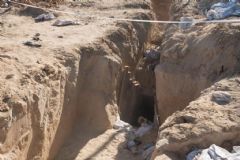Share
Human Rights Voices
While the UN devotes its human rights operations to the demonization of the democratic state of Israel above all others and condemns the United States more often than the vast majority of non-democracies around the world, the voices of real victims around the world must be heard.
Palestinian Authority/Gaza, July 8, 2019
IDF uncovers cross-border attack tunnel from southern Gaza into Israel
Original source
The military on Monday uncovered a cross-border attack tunnel that entered Israeli territory from the Gaza Strip, five years after the start of a 2014 operation aimed at finding and destroying such passages.
The tunnel was found during the construction of an underground barrier around the coastal enclave, the Israel Defense Forces said.
It was not immediately clear if the tunnel uncovered on Monday was newly dug or an older passage that had not yet been found by the IDF.
"At this time, IDF soldiers are conducting an investigation of the passage. More information will be provided shortly," the army said in a statement on Monday night.
A spokesperson for the Eshkol region, in which the tunnel was found, said the local government was in contact with the military about the matter.
"The tunnel does not represent a threat and it is being taken care of by the IDF," the regional council said in a message to residents.
The cross-border tunnel is the 18th discovered since the end of the 2014 war, according to Channel 12 news.
The military proposed building the underground barrier on the Gaza border following the 2014 Gaza war, known in Israel as Operation Protective Edge. During the fighting, Hamas made extensive use of its tunnel networks to send fighters into Israel as well as to move its terrorist operatives and munitions within the Gaza Strip.
Work began in earnest on the Defense Ministry-led project in 2016. According to the military, it is due to be completed by the end of 2019.
The 65-kilometer (40 mile) barrier is being constructed entirely inside Israeli territory, 50 meters (some 55 yards) from the Gaza border at its closest point and 300 meters (328 yards) away at its farthest.
Hundreds of people, some Israeli and others from abroad, are involved in the project, wearing flak jackets and under guard by IDF soldiers as protection against attack from terror groups in the Strip.
Concrete factories were built next to the Gaza Strip to speed up construction.
To build the underground wall, the workers are using a common construction technique known as "slurry walls," in which they dig narrow vertical slits straight down into the ground and then fill it with reinforced, sensor-laden concrete, which acts as both a physical barrier and a detection system.
The workers use a hydromill, a powerful piece of drilling equipment brought to Israel from Germany that cuts deep holes into the earth.
In addition to opening up the ground where the barrier will be constructed, the hydromill also exposes any previously undiscovered or newly dug Hamas tunnels that enter Israeli territory. The space left behind by the hydromill - and any Hamas tunnels that get in the way - is filled with a substance known as bentonite, a type of absorbent clay that expands when it touches water.
This is meant to prevent the trenches from collapsing, but also has the additional benefit of indicating the presence of a tunnel, as the bentonite would quickly drain horizontally into it.
To create the wall, workers later pour regular concrete into the trench and reinforce it using metal supports with censors attached.
All told, the fortification of the Gaza border is expected to cost some NIS 3 billion ($877 million), with NIS 2.4 billion ($700 million) of that going toward the subterranean wall.
In addition to the underground barrier, the army also began construction earlier this year on a new metal fence, some six meters (26 feet) tall, as well as adding additional breakwaters on the coast around Gaza and other protective measures in order to prevent infiltration into Israel from the sea, as occurred during the 2014 Gaza war.

